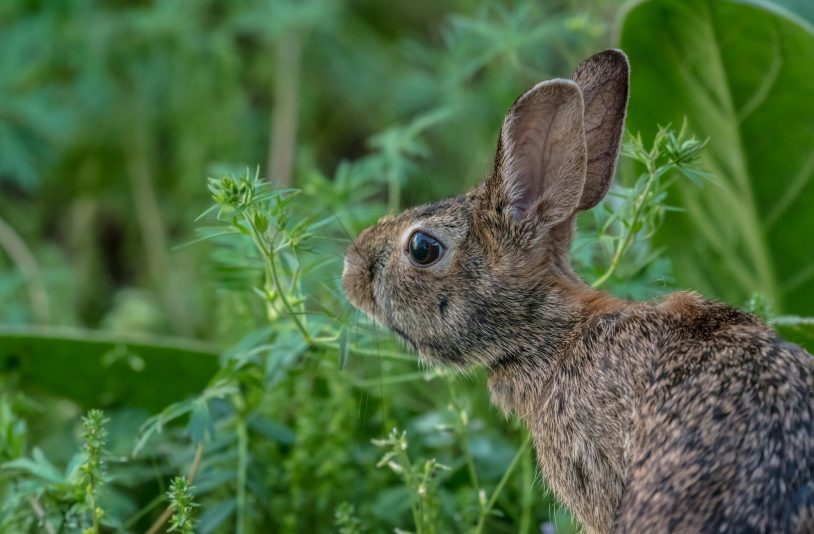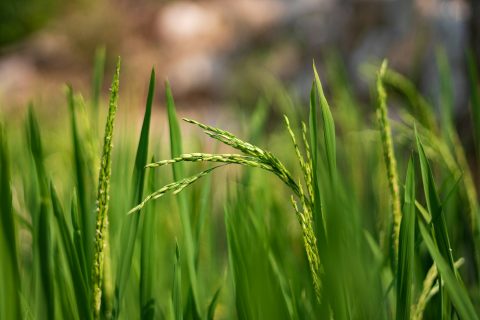
Animals can quickly turn your garden into a mess. They dig up soil, chew leaves, and steal the ripest tomatoes or peppers right before harvest. Deer, raccoons, squirrels, and other pests often see your hard work as an easy meal.
Physical barriers are one of the best ways to keep them out. Fences, chicken wire, or raised beds can make it harder for animals to invade your space. Sometimes, adding strong smells like garlic or using motion-activated tools also helps.
This guide will show you how to keep animals out of your garden. Simple tips can save your plants! Let’s get started.
Jump to Section [Hide]
Identify the Culprits
Start by figuring out which animals cause trouble in your garden. Deer and squirrels often eat plants and vegetables, and underground pests like gophers, moles, and voles dig tunnels that harm roots.
Smaller animals or insects may nibble on leaves or fruits.
Look for clues to spot the culprits. Holes in the ground point to rodents like moles. Chewed plants may signal deer, rabbits, or squirrels, as prey hunters roam nearby, hunting smaller creatures, too! Pay attention to tracks, droppings, or damaged soil around your kitchen garden or lawn each sign hints at what’s invading your space.
Use Physical Barriers
Animals can find ways into your garden, but barriers can stop them. Simple tools like fences or wire keep most pests out with ease.
1. Install Fences
Build a fence to block animals from your garden. Make it at least 8 feet tall to stop deer, as they can jump high. Use strong materials like wood posts and hardware cloth for durability.
Check gaps or holes often small pests may sneak through.
Ensure the fence surrounds the entire area. Coyotes and wolves are smart; they might find weak spots if improperly sealed off. Bury part of the fence into the ground to keep digging creatures out, too!
2. Use Bird Netting or Row Covers
To keep pests away, cover plants with bird netting or row covers. These barriers allow sunlight, air, and water through but block animals. Use tulle or fabric for small gardens. Floating row covers work well for larger areas.
Secure the edges tightly to prevent gaps where wildlife can sneak in. Pick strong netting to avoid tears caused by determined critters. This method is safe and easy for gardeners looking for pest control solutions without harming animals.
3. Install Chicken Wire
Use chicken wire to prevent animals from digging or chewing their way in. Secure the wire along the edges to create a barrier around your garden. For extra protection, bury the wire 6–12 inches deep to stop burrowing pests like rabbits or gophers.
Use hardware cloth for even stronger fencing. This works well against larger pests like raccoons. You can also build cages with this material, making 4- or 5-sided structures to shield plants completely.
These barriers are tough and long-lasting for wildlife control.
4. Cover the Soil with Pokey Materials
Spread sharp mulch over the soil, such as pinecones or thorny branches. These materials make it uncomfortable for animals to walk or dig.
Under raised beds lay rough stones, crushed eggshells, or hardware cloth. This will prevent underground pests and deter other critters from entering your garden.
5. Plant in Elevated or Enclosed Spaces
Raised beds over 3 feet high can block many animals. Rabbits and small critters often can’t jump that high. These beds also protect and keep the soil neat.
Containers like pots or window boxes shield plants from harm. You can place them on decks or patios, where animals visit less. This keeps your garden safe while adding charm to your space!
Leverage Strategic Planting
Certain plants can help keep animals away. Use these smart choices to protect your garden while adding beauty.
6. Plant Native Plants as a Norder
Dense native plants can block animals like deer. They form a natural barrier, making it harder for them to enter your garden.
In Nashville, using these plants helped protect a garden from deer damage. Choose native options in your area to create a strong border and keep out unwanted visitors.
7. Use Strong-smelling Plants
Plant herbs like sage, thyme, and oregano. Their strong scents repel pests and animals. Rabbits dislike plants such as chives, making them an excellent choice for your garden.
Grow tomatoes near vulnerable areas. Their smell helps keep rabbits away. These plants act as natural animal repellents and enhance your gardening efforts.
8. Incorporate Sacrificial Plants
Broccoli and cucumbers attract animals. Grow them away from your main garden as sacrificial plants. This will draw pests and predators to one spot instead of your prized plants.
Choose fast-growing vegetables or easy-to-replace crops for this purpose. They act as a decoy, saving the rest of your garden. Deer often avoid some vegetation but love others. Use that to your advantage! Keeping their attention on certain plants can protect everything else.
Apply Animal Repellents
Use sprays or scents to keep animals away. Explore options that suit your garden needs!
9. Commercial repellents
Commercial repellents keep animals away from strong smells or unpleasant tastes. Deer repellents, for example, use ingredients like garlic or peppermint oil to confuse deer and prevent them from entering your garden.
Spray these products on plants or around borders to protect them. Reapply often, especially after heavy rain. Many are safe for pets and kids, but always check the label before use.
10. DIY Natural Sprays
Make your hot sauce spray. In a spray bottle, mix 1 tablespoon of liquid detergent, half a bottle of hot sauce, and water. Spray the mixture around the garden to keep animals away.
Another option is to use garlic and chili powder. Add both to the water and let it sit overnight. Strain and spray on plants or soil. These strong smells bother burrowing animals like moles or gophers, but won’t harm them.
11. Mulch with strong scents
Spread mulch made from materials with strong smells. Wood chips infused with essential oils like peppermint or citrus can help. Sprinkle a few drops of these oils in areas where animals are problematic.
Hang bars of deodorant soap near plants to repel deer. The scent confuses and deters them from entering your garden. For lasting results, refresh the soap or oils every few weeks.
Modify Your Garden Design
Change the layout to make it less inviting for animals. Small tweaks can make a big difference!
12. Use Raised Beds or Pots
Raised garden beds taller than 3 feet help keep animals away. Most small critters, like rabbits, can’t reach plants that high. Pots and window boxes also work well to protect your plants.
Place them on porches or balconies for extra safety. Pots made of sturdy materials, like clay or metal, last longer outdoors.
Elevated spaces make it harder for pests to dig up soil. They also allow you to better control the environment, such as watering and drainage. If needed, add barriers around raised beds. These simple methods block animal damage and keep your plants thriving!
13. Create Pathways With Gravel or Stones
Lay gravel or stones to make paths in your garden. Animals dislike walking on uneven, hard surfaces, which can prevent them from wandering into unwanted areas. Gravel also makes noise when stepped on, alerting you to movement.
For better results, choose small stones or sharp-edged gravel. These materials withstand all weather, keeping paths neat and durable. To protect plants effectively, use this method along edges or near problem spots.
14. Add Garden Lights or Reflective Objects
Shiny objects can confuse animals. Hang aluminum foil, CDs, or reflective tape around your garden. These objects will flash when they move, scaring pests like birds and deer.
Garden lights can also help protect plants. Use solar-powered ones to save energy. Light at night might make some animals avoid the area out of fear. Both options are easy and cheap ways to keep critters away!
Employ Scare Tactics
Scaring animals can keep them away from your garden. Use clever tricks to make your space less inviting for unwanted visitors.
15. Install motion-activated sprinklers
Place motion-activated sprinklers near garden edges or problem spots. These devices spray water when animals come close, startling them. They work on deer, rabbits, and more. The Scarecrow Motion-Activated Sprinkler is a great option.
It uses sensors to detect movement and sprays only when needed.
This method saves water and keeps pests away without harming them. Adjust the range and direction to cover your garden space fully. Combine these with other protective steps like fencing or repellents for best results.
16. Use Reflective or Noisy Materials
Hang shiny objects like pie pans or CDs around your garden. Their reflections scare animals away, and their sound in the wind adds extra protection. You can also use wind chimes for noise and decoration.
Move items like plastic owls or rubber snakes often to keep animals cautious. Leaving them in one spot too long makes them less effective. Switch their locations every few days to keep pests guessing.
17. Fake Predators
Place rubber snakes around your garden beds. Squirrels and birds will think they’re real and stay away. Move them every few days to keep the illusion alive.
Set up plastic owls on fence posts or near plants. Make sure to shift their position; often, animals notice if they don’t move. Use dog scents or scatter some hair nearby too. This tricks pests into thinking a predator is nearby, keeping them out of your space.
Encourage Natural Predators
Welcome natural helpers, like birds and insects, to keep pests in check. Learn how to make your garden a friendlier spot for them!
18. Attract beneficial animals
Bring birds to your garden. They eat slugs, snails, and caterpillars that harm your plants. Add birdhouses to shelter them. Place feeders filled with seeds or suet to invite more birds.
Install a small fountain or birdbath for drinking and bathing. Moving water quickly attracts birds. This simple step keeps pests away while making your garden lively!
19. Create a Wildlife-friendly Habitat
Place owl boxes on tall trees. Owls eat pests like squirrels and chipmunks, keeping them away from your garden. They hunt at night, making them a natural solution.
Plant shrubs or flowers that attract insects and birds. These animals can help balance the ecosystem by controlling smaller pests. Keep water sources nearby for helpful wildlife, too.
Maintain Consistency and Adapt
To protect your garden, keep trying new methods, swapping old ones, and staying alert. You can always do more!
20. Rotate Deterrents
Switch up your methods often. Animals adapt fast to the same tricks. Use different repellents every 5-7 days or after it rains. Try natural sprays for one week, then install reflective objects for the next.
Change barriers to keep them guessing, too. For example, move fake predators or noisy items around your garden. This will keep animals wary and away from your plants!
21. Monitor Your Garden
Check your garden often for signs of animals. Look for tracks, droppings, or damaged plants. Early spotting helps you act quickly before problems worsen.
Keep an eye out at different times of the day. Some animals, like deer, are active at dusk, while others are active at night. Adjust your methods as needed to stay ahead of them.
The Bottom Line
Keeping animals out of your garden takes effort, but it works! Use strong fences or covers to block pests. Plant smart by adding strong-smelling herbs or sacrificial plants. Try sprays, lights, or noise to scare them away.
Let nature help by inviting friendly predators like birds. If one method isn’t enough, switch it up. Stay flexible! Start today and protect your hard work!








